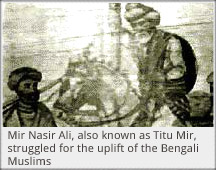The first half of the 19th century witnessed a movement known as Faraizi Movement in East Bengal. The founder of this movement was Haji Shariatullah. At this time the condition of the Bengali Muslims in the Sub-continent was very miserable. The British policy of distrust and oppression towards the Muslims rendered them economically and educationally crippled; and the oppression of the Zamindars made their lives unbearable.
 Haji Shariatullah went to Mecca on the Pilgrimage. He returned to his country after 20 years and started his reform movement known as the Faraizi movement. His movement basically targeted the most depressed class of the Muslims. He asked them to give up un-Islamic customs and practices and to act upon the commandments of the religion called Faraiz or duties. Hence his followers came to be known as Faraizi. He forbade Tazia on the occasion of Muharram and singing and dancing at the time of wedding ceremonies. His movement was also directed against the oppression of the Zamindars. He declared the country Dar-ul-Harab, as Eid and Friday prayers could not be offered there.
Haji Shariatullah went to Mecca on the Pilgrimage. He returned to his country after 20 years and started his reform movement known as the Faraizi movement. His movement basically targeted the most depressed class of the Muslims. He asked them to give up un-Islamic customs and practices and to act upon the commandments of the religion called Faraiz or duties. Hence his followers came to be known as Faraizi. He forbade Tazia on the occasion of Muharram and singing and dancing at the time of wedding ceremonies. His movement was also directed against the oppression of the Zamindars. He declared the country Dar-ul-Harab, as Eid and Friday prayers could not be offered there.
The movement infused new life into the lives of the Muslims of Bengal. It wrought great agitation among them, especially the peasants who were imbued with his doctrines. Thus, he sowed the seeds of independence in Bengal. He died in 1840.
His son Muhammad Mohsin, known as Dadhu Mian, succeeded Haji Shariatullah. Dadhu Mian popularized and strengthened the movement by organizing it in a systematic way. He acquired great influence amongst the Muslim peasants and craftsmen of Bakerganj, Dhaka, Faridpur and Pabna districts. He appointed Khalifahs who kept him informed about everything in their jurisdiction. Dadhu Mian vehemently opposed the taxes imposed by the landlords on Muslim peasants for the decoration of the image of Durgah.
He asked his followers to settle in lands managed by the government. During the revolt of 1857, he was put under arrest for organizing the peasants of Faridpur districts against the British government. He died in 1860.
Mir Nasir Ali, known as Titu Mir is another important figure who was moved by the sufferings of the Muslim of Bengal. After returning from Pilgrimage, Titu Mir devoted himself to the cause of his country. He made Narkelbaria, a village near Calcutta, the center of his activities. Many oppressed Muslim peasants gathered round Titu Mir in their resistance against the Hindu landlord, Krishna Deva Raj. Titu Mir was able to defeat Krishna Deva and set up government. The British aiding the Hindu landlords sent an army of 100 English Soldiers and 300 sepoys to Narkelbaria. In 1831, Titu Mir died fighting the British forces.
The death of Titu Mir did not dishearten his followers. His example rather served as a source of inspiration for them in the years to come.
This article was last updated on Sunday, June 01, 2003






